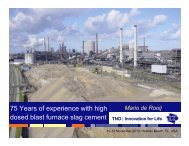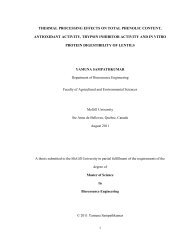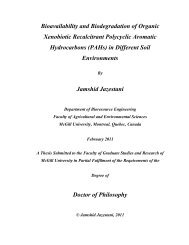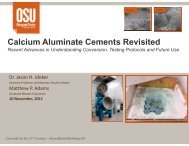Postharvest treatments to reduce chilling injury symptoms in stored ...
Postharvest treatments to reduce chilling injury symptoms in stored ...
Postharvest treatments to reduce chilling injury symptoms in stored ...
Create successful ePaper yourself
Turn your PDF publications into a flip-book with our unique Google optimized e-Paper software.
lychee, and nectar<strong>in</strong>e; it has been approved for grapefruit, papaya, and mango. The<br />
disadvantage of this treatment is fruit weight loss and shrivell<strong>in</strong>g which occurs due <strong>to</strong> low<br />
air humidity.<br />
2.3.3 Hot water-treatment (HWT)<br />
Hot water (HW) is an effective heat transfer medium and, with<strong>in</strong> a short time a<br />
uniform temperature profile will be ma<strong>in</strong>ta<strong>in</strong>ed (Couey, 1989). The additional benefit of<br />
HWT is that it can control postharvest diseases such as anthracnose and stem end rot<br />
(Couey 1989; McGuire 1991). This treatment is commonly used for dis<strong>in</strong>festation of<br />
mango from fruit flies (Sharp et al., 1988, 1989; Sharp 1986; Segarra-Carmona et al.,<br />
1990; Nascimen<strong>to</strong> et al., 1992). This treatment is cheaper than any other heat-treatment<br />
and is also effective on commercial scale <strong>in</strong> the USA. Recommended temperature ranges<br />
are between 43-46 °C; above 46 ºC the fruit experiences excessive damage. Usually a<br />
s<strong>in</strong>gle dip procedure is used either <strong>in</strong> batch process or cont<strong>in</strong>uously for 65-90 m<strong>in</strong><br />
depend<strong>in</strong>g on fruit size and cultivars.<br />
2.3.4 Physiological responses <strong>to</strong> heat-treatment<br />
Physiological response <strong>to</strong> heat treatment <strong>in</strong> the fruits has been summarized by<br />
Jacobi et al., (2001), accord<strong>in</strong>g <strong>to</strong> that:<br />
i) Heat-treatment <strong>in</strong>creases fruit heat <strong>to</strong>lerance which depends upon a number of<br />
fac<strong>to</strong>rs <strong>in</strong>clud<strong>in</strong>g species, stage of fruit maturity, fruit size, exposure <strong>to</strong><br />
different environmental fac<strong>to</strong>rs, time, duration and type of application.<br />
ii) When harvested fruits are transferred from ambient growth temperature <strong>to</strong> an<br />
elevated temperature, stress is <strong>in</strong>duced and the impact depends upon length of<br />
exposure and temperature difference.<br />
iii) Heat-treatment also develops external or <strong>in</strong>ternal heat <strong>in</strong>juries <strong>in</strong> many<br />
cultivars.<br />
iv) Heat-treatment can affect fruits ripen<strong>in</strong>g either <strong>in</strong>hibit<strong>in</strong>g, promot<strong>in</strong>g or<br />
disrupt<strong>in</strong>g the ripen<strong>in</strong>g process.<br />
v) Heat-treatment accelerates the yellow<strong>in</strong>g of the mango fruit sk<strong>in</strong> and<br />
uniformity of sk<strong>in</strong> color is also observed. However, <strong>in</strong> many cultivars fruit<br />
15









